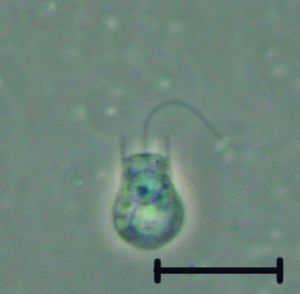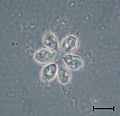Choanoflagellate facts for kids
Quick facts for kids ChoanoflagellatesTemporal range: 900–0Ma
No fossils known, molecular clock evidence for origin 1050-800Ma
|
|
|---|---|
 |
|
| Codosiga sp. | |
| Scientific classification |
|
| (unranked): | Obazoa |
| (unranked): | Opisthokonta |
| (unranked): | Holozoa |
| (unranked): | Filozoa |
| (unranked): | Choanozoa |
| Class: | Choanoflagellatea Cavalier-Smith, 1998 |
| Orders & families | |
|
|
| Synonyms | |
|
|
Choanoflagellates are tiny living things that you can only see with a microscope. They are a special type of eukaryote, which means their cells have a clear nucleus, just like animal and plant cells.
These amazing creatures have a unique "collar" and a whip-like tail called a flagellum. Some choanoflagellates live alone as single cells, while others join together to form small groups or colonies.
Contents
What Are Choanoflagellates?
Choanoflagellates are often thought of as a link between single-celled organisms and animals. This is because they look a lot like the cells found in sponges, which are some of the simplest animals.
Tiny Living Things
Choanoflagellates are very small. Each cell has a special structure that looks like a funnel or collar. Inside this collar are tiny finger-like parts called microvilli. The flagellum, or tail, sticks out from the center of the collar.
How They Eat and Live
Unlike plants, choanoflagellates do not have chloroplasts. This means they cannot make their own food using sunlight. Instead, they are heterotrophic, which means they get their food by eating other small particles.
They use their flagellum to create a water current. This current pulls tiny bits of food, like bacteria, towards their collar. The food then gets trapped by the microvilli and eaten. It's like they have a tiny fishing net!
Why Are They Important?
Scientists are very interested in choanoflagellates because they might be the closest living relatives to all animals. Studying them helps us understand how the first animals evolved from single-celled life forms.
What is a Colony?
Some choanoflagellates live in groups called colonies. These colonies can be simple, with just a few cells, or more complex, with many cells working together. Even though they are together, each cell in the colony can often still live on its own. This is different from true multicellular animals, where cells specialize and cannot live alone.
Images for kids
-
Drawing of a choanoflagellate colony by Metchnikoff, 1886
-
Monosiga brevicollis under PCM
-
Codosiga colony under light microscopy
See also
 In Spanish: Coanoflagelados para niños
In Spanish: Coanoflagelados para niños








